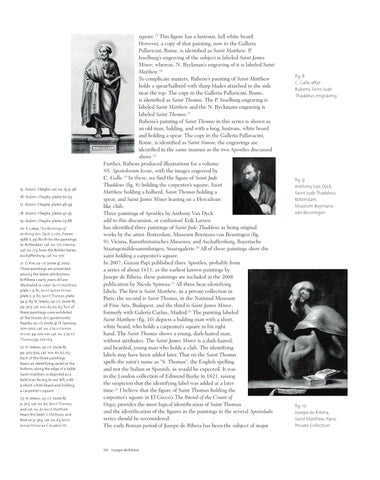15 Ibidem, Vlieghe, cat. no. 15, p. 46. 16 Ibidem, Vlieghe, plates 50-53. 17 Ibidem, Vlieghe, plates 46-49. 18 Ibidem, Vlieghe, plates 42-45. 19 Ibidem, Vlieghe, plates 73-88. 20 E. Larsen, The Paintings of Anthony Van Dyck, 2 vols., Freren 1988, II, pp. 80-81 for the paintings in: Rotterdam, cat. no. 172; Vienna, cat. no. 173, from the Böhler Series; Aschaffenburg, cat. no. 170. 21 G. Papi, op. cit. (note 4), 2007. These paintings are presented among the latest attributions to Ribera’s early years. All are illustrated in color: Saint Matthew, plate 1, p. 61; Saint James Minor, plate 2, p. 62; Saint Thomas, plate 3a, p. 63. N. Spinosa, op. cit. (note 6), pp. 303, cat. nos. A1, A2, A3. Two of these paintings were exhibited at the Museo di Capodimonte, Naples, op. cit. (note 4), N. Spinosa, 2011-2012, cat. no. 2 Saint James Minor, pp. 100-101, cat. no. 3 Saint Thomas,pp. 102-103. 22 N. Spinosa, op. cit. (note 6), pp. 303-304, cat. nos. A1, A2, A3. Each of the three paintings bears an identifying cartel at the bottom, along the edge of a table. Saint Matthew is depicted as a bald man facing to our left, with a short, white beard and holding a carpenter’s square. 23 N. Spinosa, op. cit. (note 6), p. 303, cat. no. A2, Saint Thomas, and cat. no. A1 Saint Matthew bears the label: S. Mathaeo, and that on p. 304, cat. no. A3 Saint James Minor as S. Jacobvs. Mi.
square.15 This figure has a lustrous, full white beard. However, a copy of that painting, now in the Galleria Pallavicini, Rome, is identified as Saint Matthew. P. Isselburg’s engraving of the subject is labeled Saint James Minor; whereas, N. Ryckman’s engraving of it is labeled Saint Matthew.16 To complicate matters, Rubens’s painting of Saint Matthew holds a spear/halberd with sharp blades attached to the side near the top. The copy in the Galleria Pallavicini, Rome, is identified as Saint Thomas. The P. Isselburg engraving is labeled Saint Matthew and the N. Ryckmans engraving is labeled Saint Thomas.17 Rubens’s painting of Saint Thomas in this series is shown as an old man, balding, and with a long, lustrous, white beard and holding a spear. The copy in the Galleria Pallavacini, Rome, is identified as Saint Simon; the engravings are identified in the same manner as the two Apostles discussed above.18 Further, Rubens produced illustrations for a volume: SS. Apostolorum Icone, with the images engraved by C. Galle.19 In these, we find the figure of Saint Jude Thaddeus (fig. 8) holding the carpenter’s square, Saint Matthew holding a halberd, Saint Thomas holding a spear, and Saint James Minor leaning on a Herculeanlike club. Three paintings of Apostles by Anthony Van Dyck add to this discussion, or confusion! Erik Larsen has identified three paintings of Saint Jude Thaddeus as being original works by the artist: Rotterdam, Museum Boymans-van Beuningen (fig. 9); Vienna, Kunsthistorisches Museum; and Aschaffenburg, Bayerische Staatsgemäldesammlungen, Staatsgalerie.20 All of these paintings show the saint holding a carpenter’s square. In 2007, Gianni Papi published three Apostles, probably from a series of about 1611, as the earliest known paintings by Jusepe de Ribera; these paintings are included in the 2008 publication by Nicola Spinosa.21 All three bear identifying labels. The first is Saint Matthew, in a private collection in Paris; the second is Saint Thomas, in the National Museum of Fine Arts, Budapest; and the third is Saint James Minor, formerly with Galería Caylus, Madrid.22 The painting labeled Saint Matthew (fig. 10) depicts a balding man with a short, white beard, who holds a carpenter’s square in his right hand. The Saint Thomas shows a young, dark-haired man, without attributes. The Saint James Minor is a dark-haired, and bearded, young man who holds a club. The identifying labels may have been added later. That on the Saint Thomas spells the saint’s name as “S. Thomas”, the English spelling and not the Italian or Spanish, as would be expected. It was in the London collection of Edmund Burke in 1821, raising the suspicion that the identifying label was added at a later time.23 I believe that the figure of Saint Thomas holding the carpenter’s square in El Greco’s The Burial of the Count of Orgaz provides the most logical identification of Saint Thomas and the identification of the figures in the paintings in the several Apostolado series should be reconsidered. The early Roman period of Jusepe de Ribera has been the subject of major
68 Jusepe de Ribera
fig. 8 C. Galle after Rubens, Saint Jude Thaddeus, engraving
fig. 9 Anthony Van Dyck, Saint Jude Thaddeus, Rotterdam, Museum Boymansvan Beuningen
fig. 10 Jusepe de Ribera, Saint Matthew, Paris, Private Collection
